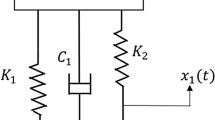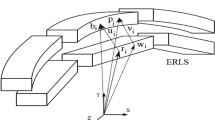Abstract
A formulation of impedance control for redundant manipulators is presented here as a particular case of an optimal control problem. This allows the design of an impedance controller that benefits from the stability and efficiency of an optimal controller. To circumvent the high computational costs of finding optimal controllers, a suboptimal feedback controller based on state-dependent Riccati equations (SDRE) is developed. This approach is compared with the quadratic programming (QP) formulation, commonly used to solve redundancy of robotic manipulators. Numerical simulations of a redundant planar four-DOF serial-link manipulator show that the SDRE controller offers superior performance over the QP one in terms of stability, performance and required control effort.









Similar content being viewed by others
References
Adams RJ, Hannaford B (1999) Stable haptic interaction with virtual environments. IEEE Trans Robot Autom 15(3):465–474
Aguirre-Ollinger G, Colgate JE, Peshkin MA, Goswami A (2007) Active-impedance control of a lower-limb assistive exoskeleton. In: IEEE 10th International conference on rehabilitation robotics, 2007. ICORR 2007. IEEE, pp 188–195
Arevalo JC, Garcia E (2012) Impedance control for legged robots: an insight into the concepts involved. IEEE Trans Syst Man Cybern Part C (Appl Rev) 42(6):1400–1411
Beeler S, Tran H, Banks H (2000) Feedback control methodologies for nonlinear systems. J Optim Theory Appl 107(1):1–33
Bellman R (1957) Dynamic programming and the numerical solution of variational problems. Oper Res 5:277–288
Bowling A, Harmeyer S (2010) Repeatable redundant manipulator control using nullspace quasivelocities. J Dyn Syst Meas Control 132(3):031007
Burdet E, Franklin DW, Milner TE (2013) Human robotics: neuromechanics and motor control. MIT Press, Cambridge
Carelli R, Kelly R (1991) An adaptive impedance/force controller for robot manipulators. IEEE Trans Autom Control 36(8):967–971
Chang KS, Khatib O (1995) Manipulator control at kinematic singularities: a dynamically consistent strategy. In: Intelligent robots and systems 95.’Human robot interaction and cooperative robots’, Proceedings. 1995 IEEE/RSJ international conference on, vol 3. IEEE, pp 84–88
Chen D, Zhang Y (2017) A hybrid multi-objective scheme applied to redundant robot manipulators. IEEE Trans Autom Sci Eng 14(3):1337–1350
Chevallereau C, Abba G, Aoustin Y, Plestan F, Westervelt E, De Wit CC, Grizzle J (2003) Rabbit: a testbed for advanced control theory. IEEE Control Syst Mag 23(5):57–79
Cimen T (2008) State-dependent riccati equation (sdre) control: a survey. IFAC Proc Vol 41(2):3761–3775
Cimen T (2012) Survey of state-dependent riccati equation in nonlinear optimal feedback control synthesis. J Guid Control Dyn 35(4):1025–1047
Cloutier JR (1997) State-dependent Riccati equation techniques: an overview. In: American control conference, 1997. Proceedings of the 1997, vol 2. IEEE, pp 932–936
Crain A, Ulrich S (2019) Experimental validation of pseudospectral-based optimal trajectory planning for free-floating robots. J Guid Control Dyn 42:1–17
Erdem EB, Alleyne AG (2001) Experimental real-time SDRE control of an underactuated robot. In: Proceedings of the 40th IEEE conference on decision and control, 2001, vol 3. IEEE, pp 2986–2991
Fahroo F, Ross I (2000) Trajectory optimization by indirect spectral collocation methods. In: Astrodynamics specialist conference, p 4028
Ferraguti F, Preda N, Manurung A, Bonfe M, Lambercy O, Gassert R, Muradore R, Fiorini P, Secchi C (2015) An energy tank-based interactive control architecture for autonomous and teleoperated robotic surgery. IEEE Trans Robot 31(5):1073–1088
Härkegård O, Glad ST (2005) Resolving actuator redundancy—optimal control vs. control allocation. Automatica 41(1):137–144
He W, Dong Y, Sun C (2016) Adaptive neural impedance control of a robotic manipulator with input saturation. IEEE Trans Syst Man Cybern Syst 46(3):334–344
Hogan N (1984) Impedance control: an approach to manipulation. In: American control conference, 1984. IEEE, pp 304–313
Hollerbach J, Suh K (1987) Redundancy resolution of manipulators through torque optimization. IEEE J Robot Autom 3(4):308–316
Hu YR, Goldenberg AA (1993) Dynamic control of coordinated redundant robots with torque optimization. Automatica 29(6):1411–1424
Kalman R (1963) The theory of optimal control and the calculus of variations. Mathematical optimization techniques, pp 309–331
Khatib O (1987) A unified approach for motion and force control of robot manipulators: the operational space formulation. IEEE J Robot Autom 3(1):43–53
Korayem MH, Nekoo SR (2015) Finite-time state-dependent riccati equation for time-varying nonaffine systems: rigid and flexible joint manipulator control. ISA Trans 54:125–144
Korayem MH, Nekoo SR (2015) Suboptimal tracking control of nonlinear systems via state-dependent differential Riccati equation for robotic manipulators. In: 2015 3rd RSI international conference on robotics and mechatronics (ICROM). IEEE, pp 025–030
Li Z, Huang Z, He W, Su CY (2017) Adaptive impedance control for an upper limb robotic exoskeleton using biological signals. IEEE Trans Ind Electron 64(2):1664–1674. https://doi.org/10.1109/TIE.2016.2538741
Mussa-Ivaldi FA, Hogan N (1991) Integrable solutions of kinematic redundancy via impedance control. Int J Robot Res 10(5):481–491
Nakamura Y, Hanafusa H, Yoshikawa T (1987) Task-priority based redundancy control of robot manipulators. Int J Robot Res 6(2):3–15
Nenchev DN (1989) Redundancy resolution through local optimization: a review. J Field Robot 6(6):769–798
Okamura AM (2004) Methods for haptic feedback in teleoperated robot-assisted surgery. Ind Robot Int J 31(6):499–508
O’Neil KA (2002) Divergence of linear acceleration-based redundancy resolution schemes. IEEE Trans Robot Autom 18(4):625–631
Oriolo G (1994) Stabilization of self-motions in redundant robots. In: 1994 IEEE international conference on robotics and automation, 1994. Proceedings. IEEE, pp 704–709
Oriolo G, Cefalo M, Vendittelli M (2017) Repeatable motion planning for redundant robots over cyclic tasks. IEEE Trans Robot 33(5):1170–1183
Ott C, Dietrich A, Albu-Schäffer A (2015) Prioritized multi-task compliance control of redundant manipulators. Automatica 53:416–423
Pearson J (1962) Approximation methods in optimal control I. Sub-optimal control. Int J Electron 13(5):453–469
Pesch HJ (1989) Real-time computation of feedback controls for constrained optimal control problems. Part 1: neighbouring extremals. Opt Control Appl Methods 10(2):129–145
Peters J, Mistry M, Udwadia F, Nakanishi J, Schaal S (2008) A unifying framework for robot control with redundant dofs. Auton Robots 24(1):1–12
Pontryagin LS (1987) Mathematical theory of optimal processes. CRC Press, Boca Raton
Roberts RG, Maciejewski AA (1993) Repeatable generalized inverse control strategies for kinematically redundant manipulators. IEEE Trans Autom Control 38(5):689–699
Ross SM, Cobb RG, Baker WP, Harmon FG (2015) Implementation lessons and pitfalls for real-time optimal control with stochastic systems. Opt Control Appl Methods 36(2):198–217
Rossi LF, Parik-Americano P, Simões IFE, Forner-Cordero A (2019) Predicted step viability: a stability criterion for biped gait. J Br Soc Mech Sci Eng 41(12):548
Sadeghian H, Villani L, Keshmiri M, Siciliano B (2014) Task-space control of robot manipulators with null-space compliance. IEEE Trans Robot 30(2):493–506
Schlegl T, Buss M, Omata T, Schmidt G (2001) Fast dextrous re-gras** with optimal contact forces and contact sensor-based impedance control. In: IEEE international conference on robotics and automation, 2001. Proceedings 2001 ICRA, vol 1. IEEE, pp 103–108
Semini C, Barasuol V, Boaventura T, Frigerio M, Focchi M, Caldwell DG, Buchli J (2015) Towards versatile legged robots through active impedance control. Int J Robot Res 34(7):1003–1020
Singh SK, Popa DO (1995) An analysis of some fundamental problems in adaptive control of force and impedance behavior: theory and experiments. IEEE Trans Robot Autom 11(6):912–921
Suh K, Hollerbach J (1987) Local versus global torque optimization of redundant manipulators. In: 1987 IEEE international conference on robotics and automation. Proceedings, vol 4. IEEE, pp 619–624
Tafazoli S, Salcudean SE, Hashtrudi-Zaad K, Lawrence PD (2002) Impedance control of a teleoperated excavator. IEEE Trans Control Syst Technol 10(3):355–367
Tsagarakis NG, Caldwell DG (2003) Development and control of a ‘soft-actuated’ exoskeleton for use in physiotherapy and training. Auton Robots 15(1):21–33
Watanabe K, Iwase M, Hatakeyama S, Maruyama T (2009) Control strategy for a snake-like robot based on constraint force and verification by experiment. Adv Robot 23(7–8):907–937
Xu Q (2013) Adaptive discrete-time sliding mode impedance control of a piezoelectric microgripper. IEEE Trans Robot 29(3):663–673
Zhang Z, Lin Y, Li S, Li Y, Yu Z, Luo Y (2017) Tricriteria optimization-coordination motion of dual-redundant-robot manipulators for complex path planning. IEEE Trans Control Syst Technol 26:1345–1357
Acknowledgements
A.F.C. research is sponsored by the CNPq (Grant: 311055/2016-8).
Author information
Authors and Affiliations
Corresponding author
Ethics declarations
Conflict of interest
The authors declare that they have no conflict of interest.
Additional information
Technical Editor: Victor Juliano De Negri, D.Eng.
Publisher's Note
Springer Nature remains neutral with regard to jurisdictional claims in published maps and institutional affiliations.
Rights and permissions
About this article
Cite this article
Furtado, G.P., Americano, P.P. & Forner-Cordero, A. Impedance control as an optimal control problem: a novel formulation of impedance controllers as a subcase of optimal control. J Braz. Soc. Mech. Sci. Eng. 42, 513 (2020). https://doi.org/10.1007/s40430-020-02586-x
Received:
Accepted:
Published:
DOI: https://doi.org/10.1007/s40430-020-02586-x




